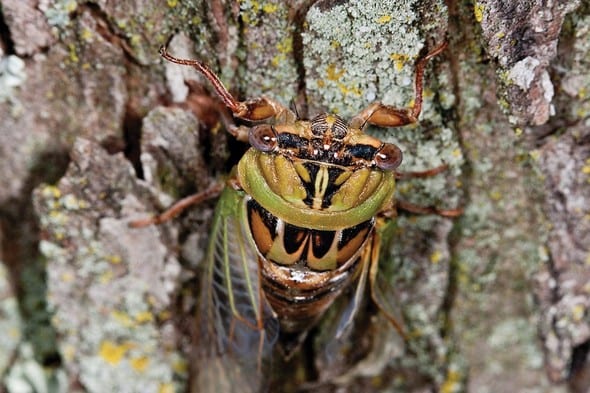
These bug-eyed insects emerge to bring us the soundtrack of summer.
JEFFERSON CITY, Mo. – It wouldn’t be a Missouri summer without the pulsating hum of its annual cicadas. The Missouri Department of Conservation (MDC) encourages you to learn more about these bug-eyed insects and the important role they play in the ecosystem.
Periodical cicadas are making headlines this year as numerous states will be visited by Brood X after spending 17 years underground. However, MDC’s Forest Entomologist Robbie Doerhoff says Missouri won’t experience periodical cicadas for another few years.
“Periodical cicadas won’t emerge in Missouri until 2024,” explained Doerhoff. “But the dog days, or annual cicadas, we see each summer will be present, and are super cool in their own way!”
Doerhoff said that several species of cicadas occur in Missouri, and they start to emerge in mid-to-late June.
“Annual cicadas look like larger and greener versions of the famous periodical cicadas,” she explained. “They spend two-to-five years living underground as nymphs and sucking juices from plant roots with their straw-like mouth parts. During the dog days of summer, nymphs will tunnel to the surface, climb a tree or other object, and molt to become a winged adult.”
After molting, which takes just a few hours, cicadas leave behind their famous shed skin. They will then sing, mate, and produce the next generation – all within just a few weeks of living above ground before dying. Notable species of annual cicadas include Robinson’s cicada, scissor grinder, buzz saw, and Northern dusk singing cicada.
“The thing that’s so neat about Missouri’s annual cicadas is how unique they are,” said Doerhoff. “You can identify species by their song and the time of day they sing.”
For example, the call of a Robinson’s annual cicada is a repetitive, rhythmic “pZEE-ape, pZEE-ape” and mostly occurs in midday. Buzz saw cicadas call from high trees with a distinctive “WHEE-oo, WHEE-oo” during the evening and at dusk.
Though their unique calls can be bothersome to some, the annual singing of males is imperative to finding a mate.
“The adult males have sound-producing membranes called tymbals that emit that loud, raspy call used to attract females,” said Doerhoff. “Studies have shown cicada calls can reach 92 decibels – which is louder than a lawn mower!”
Annual cicadas can be found statewide and are most common in wooded areas, parks, and forest borders. Females lay their eggs in the woody twigs of trees and shrubs, occasionally causing the tips of twigs to turn brown. After hatching, nymphs fall from the twigs and burrow underground to feed off tree, shrub, and perennial plant roots.
“Cicadas really thrive in areas where the land is relatively undisturbed for the years it takes the nymphs to develop underground,” explained Doerhoff.
Like many wildlife members, cicadas play an important role in Missouri’s ecosystem. They provide a food source for many species of birds, insects, spiders, and other animals that feed on large bugs. The small nymphs help aerate the soil while they burrow underground. Once they die, cicada bodies serve as an important source of nitrogen for trees.
Doerhoff stressed the importance of celebrating cicadas, as broods may be getting smaller.
“The lifecycle of a cicada is so incredible because they spend so much time underground preparing to emerge, especially the periodical cicadas, and it’s unfortunate their numbers are potentially declining,” she noted. “There are several factors that could be to blame, including urban development and pesticide use. Because they only spend a few weeks aboveground, we still have much to learn about this species.”
To help support cicadas, Doerhoff suggested steering clear of chemical use on lawns.
“Using pesticides above ground can ultimately harm cicadas,” she said. “Don’t use weed-and-feed products as they can kill tree roots that cicadas feed on. Avoid unnecessary insecticide applications to your trees and grass as these types of pesticides can kill soil-dwelling organisms that help make your backyard a healthy ecosystem.”
Learn more about these unique species and the different cicadas you can find in Missouri at https://nature.mdc.mo.gov/discover-nature/field-guide/annual-cicadas.














